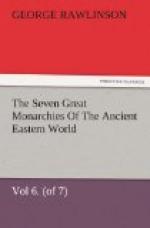The dress of the monarch was commonly the loose Median robe, which had been adopted from the Medes by the Persians. This flowed down to the feet in numerous folds, enveloping and concealing the entire figure. Trousers and a tunic were probably worn beneath it, the latter of linen, the former of silk or wool. As head-dress, the king wore either the mere diadem, which was a band or ribbon, passed once or oftener round the head, and terminating in two long ends which fell down behind, or else a more pretentious cap, which in the earlier times was a sort of Scythian pointed helmet, and in the later a rounded tiara, sometimes adorned with pearls or gems. His neck appears to have been generally encircled with two or three collars or necklaces, and he frequently wore ear-rings in his ears. The beard was almost always cultivated, and, with the hair, was worn variously. Generally both hair and beard were carefully curled; but sometimes they depended in long straight locks, Mostly the beard was pointed, but occasionally it was worn square. In later times a fashion arose of puffing out the hair at either side extravagantly, so as to give it the appearance of a large bushy wig.
In war the monarch seems to have exchanged his Median robe for a short cloak, reaching half way down the thigh. His head was protected by a helmet, and he carried the national arm of offence, the bow. He usually took the field on horseback, but was sometimes mounted on an elephant, trained to encounter the shock of battle. Gold and silver were abundantly used in the trappings of his steed and in his arms. He generally took the command, and mingled freely in the fight, though he might sometimes shrink without reproach from adventuring his own person. His guards fought about him; and he was accompanied by attendants, whose duty it was to assist him in mounting on horseback and dismounting.
The status of the queen was not much below that of her royal consort. She wore a tiara far more elaborate than his, and, like him, exhibited the diadem. Her neck was encircled with several necklaces. As the title of Theos, “God,” was often assumed by her husband, so she was allowed the title of “Goddess”, or “Heavenly Goddess”.
Separate apartments were of course assigned to the queen, and to the royal concubines in the various palaces. These were buildings on a magnificent scale, and adorned with the utmost richness. Philostratus, who wrote in Parthian times, thus describes the royal palace at Babylon. “The palace is roofed with brass, and a bright light flashes from it. It has chambers for the women, and chambers for the men, and porticos, partly glittering with silver, partly with cloth-of-gold embroideries, partly with solid slabs of gold, let into the walls, like pictures. The subjects of the embroideries are taken from the Greek mythology, and include representations of Andromeda, of Amymone, and of Orpheus, who is frequently repeated....




